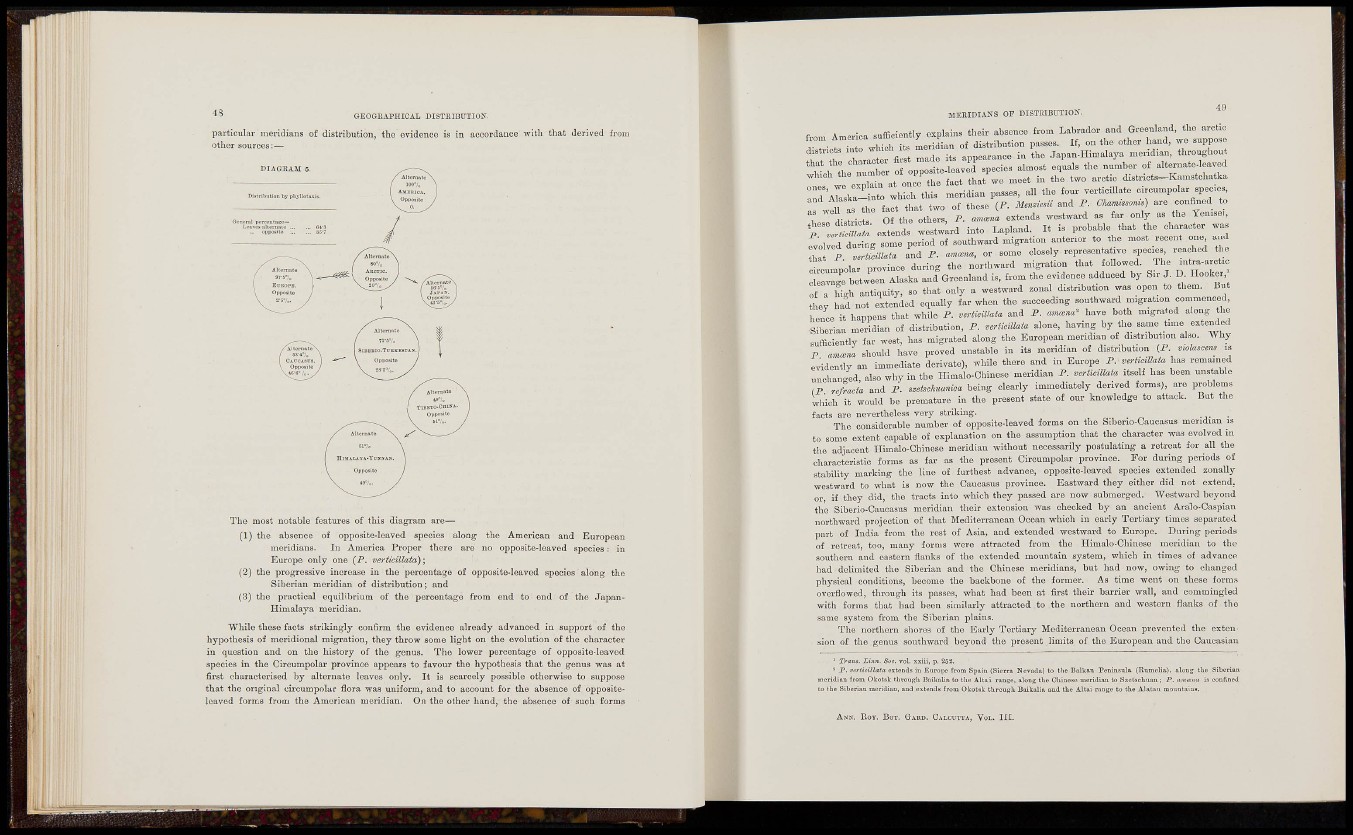
GEOGRAPHICAL DISTEIDUTION.
particular meridians of distribution, the evidence is in accordance witU that derived from
other sources:—
T h e most notable features of this diagram are—
( 1 ) the absence of opposite-leaved species along the American and European
meridians. In America Proper there are no opposite-leaved species: in
Europe only one {P. verticillaia)',
( 2 ) the progressive increase in the percentage of opposite-leaved species along the
S i b e r i a n meridian of distribution; and
( 3 ) the practical equilibrium of the percentage from end to end of the Japan-
H i m a l a y a meridian.
W h i l e these facts strikingly confirm the evidence already advanced in support of the
h y p o t h e s i s of meridional migration, they throw some light on the evolution of the character
i n question and on the history of the genus. The lower percentage of opposite-leaved
species in the Circumpolar province appears to favour the hypothesis that the genus was at
first characterised by alternate leaves only. It is scarcely possible otherwise to suppose
t h a t the orii^inal circumpokr flora was uniform, and to account for the abscnce of oppositel
e a v e d forms from the American meridian. On the other hand, the absence of such forms
MEEIDIANS OF DISTRIBUTION.
A • o cnfflríontlv explains their absence from Labrador and Greenland, the arctic
f L r ^ ' i a n of distribution passes. If, on the other hand, we suppose
districts into ap p e a r a n c e in the Japan-Himalaya meridian, throughout
that the charac er ^^ ^ th e number of alternate-leaved
o n r t i f ^ me e t in the two arctic districts-KamstchatUa
^ ^ A r s U ^ n t o which this meridian passes, all the four verticillate circumpolar .peces,
: i n tho fact that two of those (P. an d P. Cka^issoms) are confined «
, I Z L Of the others, P. ex t e n d s westward as far only as the lenise.,
e x t e n t ^estwLrd into Lapland. It is probable that the character wa.
f v o l ed ^ U pe r i o d of southward migration anterior to the most recent one and
Z T f vertLlata and P- or some closely representativo specics reached the
^ i l m p o l a r province during the northward migration that followed. The int^a arcüc
c l e a v a / e between Alaska and Greenland is, from the evidence adduced by Sir J. D. Hooker
T a S^h antiquity, so that only a westward zonal distribution was open to them. But
l y had not extended equally far when the succeeding southward migration commenced,
hence it happens that while P. verticima and P. — h a v e both migrafed along the
Siberian meridian of distribution, P. verticillaia alone, having by the same time exte^ed
sufficiently far west, has migrated along the European meridian of distribution also. Why
P amcena should have proved unstable in its meridian of distribution (P. violascens is
e v i d e n t l y an immediate derivate), whüe there and in Europe P. verticillata has remained
i m c h a n / e d also why in the Himalo-Chinese meridian P. verticinaia itself has been unstable
( P refracta and P. szetschuanica being clearly immediately derived forms), are problems
U i c h it would be premature in the present state of our knowledge to attack. But the
f a c t s are nevertheless very striking.
T h e considerable number of opposite-leaved forms on the Siberio-Caucasus meridian is
to some extent capable of explanation on the assumption that the character was evolved in
the adjacent Himalo-Chinese meridian without necessarily postulating a retreat for all the
characteristic forms as far as the present Circumpolar province. For during periods of
s t a b i l i t y marking the line of furthest advance, opposite-leaved species extended zonally
westward to what is now the Caucasus province. Eastward they either did not extend,
or, if they did, the tracts into which they passed are no-w submerged. Westward beyond
t h e Siberio-Caucasus meridian their extension was checked by an ancient Aralo-Caspian
northward projection of that Mediterranean Ocean which in early Tertiary times separated
part of India from the rest of Asia, and extended westward to Europe. During periods
of retreat, too, many forms were attracted from the Himalo-Chinese meridian to the
southern and eastern flanks of the extended mountain system, which in times of advance
had delimited the Siberian and the Chinese meridians, but had now, owing to changed
physical conditions, become the backbone of the former. As time went on these forms
overflowed, through its passes, what had been at first their barrier wall, and commingled
w i t h forms that had been similarly attracted to the northern and western flanks of the
f r om the Siberian plains.
The northern shores of the Early Tertiary Mediterranean Ocean prevented the extens
i on of the genus southward beyond the present limits of the European and the Caucasian
' Trans. Linn. Soc. Tol. xxiii, p. 252.
= P . veriicillata extecds in Europe from Spain (Sierra Nevada) to t!ie Balkan Peninsula (Runielia), aloDg tlie Siberian
meridian from Okotsk tbrougli Bnikalia to the Altai ranee, along tlie Cliictcso meridian to Szetscliuan; P. aincana is oonRned
to the Siberian meridian, and extends from Okotsk tkrough Baikaliu and the Altai range to the Alatau mountaius.
ANN. EOY. BOT. GARD, C. , YOL. III.